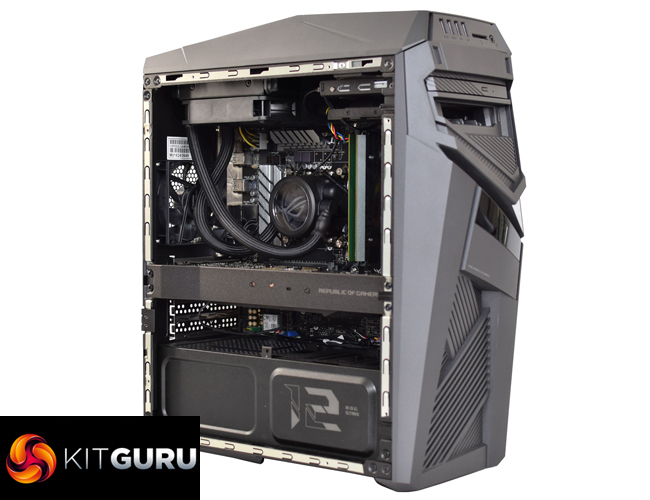Hot on the heels of both the Intel 9th Gen and Nvidia RTX launch, the ASUS ROG Strix GL12CX is the first pre-built PC we have seen to combined both new technologies in one very speedy package.
Given that its i9-9900K runs at 4.9GHz as well, the GL12CX is certainly a fast machine that could appeal for anyone looking to get some work done, be it video editing or rendering. The RTX 2080 does steer this more towards gamers, however, and it provides enough firepower for even 4K gaming, although you will get more use out of a high refresh-rate monitor if you game at 1440p.
On top of the powerful core components, the GL12CX has a number of unusual features that an end-user would struggle to find elsewhere. For one, there is the 2.5in hot swap drive bay which allows you to plug in a 2.5in SSD on the fly without opening up the insides and connecting any cables. Then there's the M.2 riser card, named DIMM.2, which provides an easy way to install another M.2 drive and prevent drive throttling. There's also an added crossbar to keep your graphics card secure in transit and prevent any sagging when it is under your desk.
Those features certainly add value to the GL12CX, but I have to say at £2999 this is a very expensive machine. Not just when taken on its own – though £3K is obviously going to put this out of reach for most people – but even if we look at the price you'd pay to build a similar machine, I priced up an almost identical set of parts and that came to just over £2200 at the time of writing.
That means you are effectively paying ASUS an £800 premium for this system. Usually, a couple hundred pounds over the individual component price is fair enough – after all, you are getting the machine built, shipped and covered by warranty. An extra £800, though? I can appreciate you do get some good features, and overall top performance from this machine, but that certainly feels very steep.
That high price doesn't take into account the issues with the system, either. The major thing being the fact that we saw the CPU peak at 103C when stressed to the limit in Prime 95 v26.6, which is a hugely concerning temperature. The figure is of course much lower if you're just gaming, but even so, ASUS' decision to raise TJMax to 115C certainly seems worrying.
There are other things to consider as well – issues like the ugly ketchup-and-mustard cabling, bare green PCB memory modules, very high noise levels when the CPU is stressed – these all add up and I think they hold this machine back.
I can still recommend the ASUS ROG Strix GL12CX if you want a fast PC with the latest hardware inside – if you're just gaming, the CPU won't go above 60C and you'll get good frame rates at 1440p and 4K. At the end of the day, however, for £3000 I can't help but feel this machine definitely needs to be more refined than it is to justify that price tag.
We don't yet have a buy link for the GL12CX, but we have been told to expect availability by the end of November.
Update: Just before publication of this review, ASUS contacted us with a new BIOS update which reduces the CPU clockspeed and should thus reduce temperatures as well. This was sent to us just as we were publishing so we can only go with what we've tested, but at least it seems ASUS is aware of the thermal issues with the GL12CX.
Pros
- 9900K and RTX 2080 pair very nicely.
- A number of good features included.
- Cool and relatively quiet when gaming.
- CPU comes overclocked at 4.9GHz.
Cons
- £800 price premium is hard to swallow.
- CPU peaked at over 100C when stressed to the limit.
- Cabling is ugly and makes access to the 3.5in drive cage tricky.
- Memory modules are bare green PCBs, with no heatspreaders.
- Noise levels are fine when gaming, but gets very loud when the CPU is stressed.
KitGuru says: It's certainly a very fast system that has two of newest pieces of hardware inside. Seeing the CPU peak at over 100C is very concerning however, and for the price ASUS is charging, the overall package does need to be more refined.
 KitGuru KitGuru.net – Tech News | Hardware News | Hardware Reviews | IOS | Mobile | Gaming | Graphics Cards
KitGuru KitGuru.net – Tech News | Hardware News | Hardware Reviews | IOS | Mobile | Gaming | Graphics Cards




